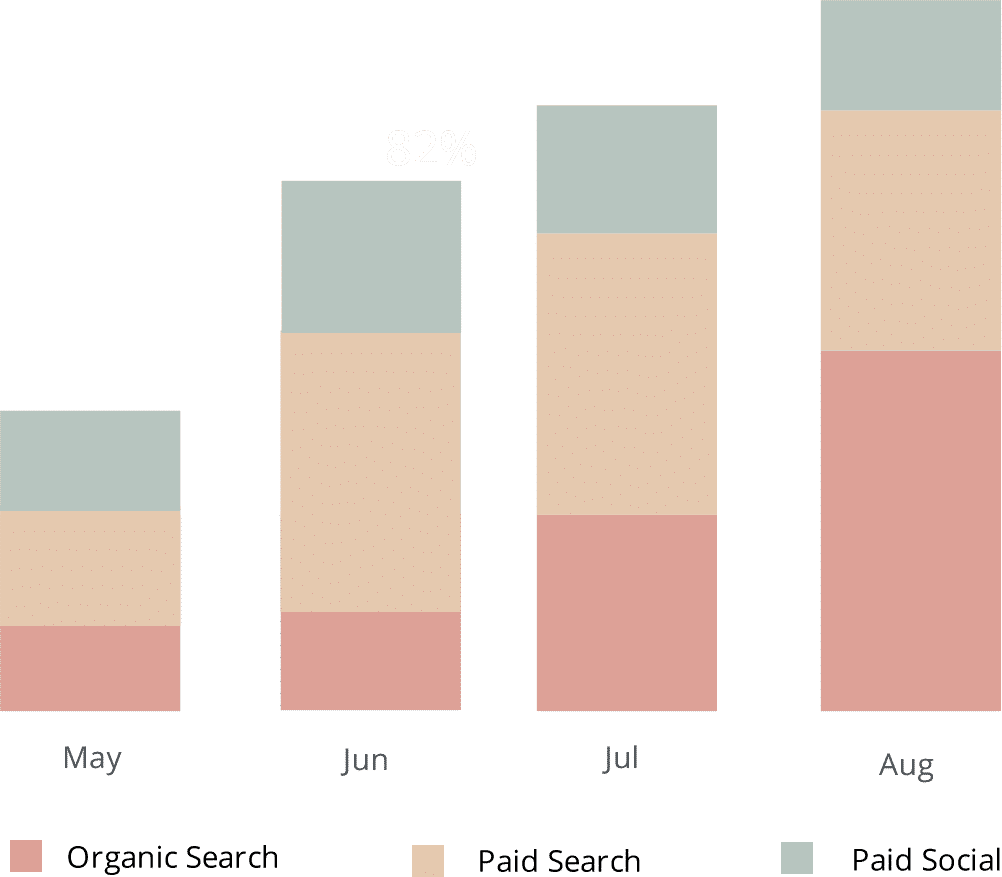The easiest way to track UTM parameters in Profitwell
Know what's driving signups, customers & revenue for your subscription business by tracking UTM parameters in Profitwell

Profitwell provides one of the best subscription revenue analytics tools on the market. Its free product connects directly to your billing system to give you instant reports on your MRR, ARR, churn, retention, LTV, and more.
Unfortunately though, Profitwell doesn't capture UTM parameters and other marketing attribution data out of the box, which make sit difficult to use it to report on the success of your various marketing channels and campaigns.
Fortunately, Attributer can help.
In this article, we're going to show you how to use Attributer to send UTM parameters (and other marketing attribution data) into Profitwell so you can use them segment your reports and understand what's working and what isn't.
What is Attributer?
Attributer, to put it simply, is a small snippet of code that you place on your website.
Every time a visitor lands on your site, Attributer takes a look at several pieces of technical information about the visitor to figure out where they came from (including, among other things, the UTM parameters in the URL).
Once this is determined, Attributer will categorise each visitor according to a series of channels (Paid Search, Organic Search, Paid Social, etc.) and store this information in a cookie in the user's browser.
And when a visitor decides to complete a form on your site (like the signup form for your subscription product), Attributer passes the UTM parameters and other data into Profitwell.
And once the data is in Profitwell, you can start creating reports that provide insights to questions such as:
- How many customers have I generated from my Google Ads?
- What's the ARPU of customers from my LinkedIn Ads vs. customers from my Facebook Ads?
- What's the total MRR generated from our organic social media efforts?
- What's the churn rate of customers who come through our SEO efforts vs customers who come through our LinkedIn Ads?
- What's the LTV of customers from our Twitter ads?
- What's the average sale price of customers who have come from our affiliates?
4 steps for analysing UTM parameters in Profitwell
Using Attributer to get UTM parameters into Profitwell is easy. Here's how to do it in 4 easy steps:
1. Add UTM variables to your ads

To start, you need to add UTM parameters to all your ads and campaigns in order to help Attributer monitor where your visitors are coming from.
This includes ads on social networks like Facebook, LinkedIn & Twitter, search engines like Google & Bing, and every bespoke campaign you may have running on industry websites, trade publications, email newsletters, etc.
2. Add the Attributer code to your website

Once you’ve finished signing up for the 14-day free trial of Attributer, a small piece of code will be provided to you to add to your site. This code can be compared to the Google Analytics code and other codes for other marketing tools you have added before. If you know what these are, you should add the Attributer code the same way you did with these other codes.
If it’s your first time, you can go to the Settings area of whatever CMS system you use (i.e., WordPress, Squarespace, etc.), and an option to add the code to the header is most likely available. On the other hand, if you’re using a tag management service like Google Tag Manager, then you can directly add the code through this tool.
If you need further assistance on adding the Attributer code to your site, please go to our help site.
3. Send the data into Profitwell

Assuming that the Attributer code is now up and running on your site, Attributer will now start to monitor your every visitor's origin and categorise them according to Channels (i.e., Organic Search, Paid Search, etc.). Once they're categorised, this data will be stored in a cookie in the visitor's browser.
To get the data into Profitwell, you need to take the data out of the cookie first. You could do this in two ways:
- Adding hidden fields in your forms - By incorporating hidden fields into your forms, Attributer will have a space to write the UTM parameters and other marketing attribution data into. When the form is submitted, the data in the fields will be passed to Profitwell along with the customer's other information (their name, email, company name, etc.)
- Get the data out of the cookie - Through a simple line of javascript that you add to your website, you will be able to retrieve the UTM parameters and other data from the Attributer cookie and pass them to Profitwell. This approach is particularly beneficial if you have the 'Sign up with Google' or 'Sign up with Facebook' buttons that let the user sign up for your product without filling out a form.
4. Run reports in Profitwell

Now that you have the UTM parameters and other attribution data in Profitwell, you can start running reports that answer your key marketing questions, including:
- How many new trials did I get from my Google Ads?
- Which Google Ad campaign drove the most trials?
- How many customers came from our Facebook Ads?
- What's the revenue retention rate of people who come from our Facebook ads vs our Google Ads?
- How many customers have we gotten from our blogging efforts?
- How many customers have come from our SEO efforts?
- And much more
Why using Attributer is better than capturing raw UTM parameters
There are other ways of getting UTM parameters into Profitwell, so what makes Attributer a better choice?
Unlike other tools, Attributer does much more than just capturing raw UTM parameters. It also does the following:
1. Captures all traffic
On top of sending UTM parameters into Profitwell, Attributer will also capture marketing attribution information on users who arrive on your site through organic channels with no UTM parameters (I.e. Organic Search, Organic Social, Direct, Referral, etc.)
With this data inside Profitwell, you will be run reports that show you the source of ALL your trials & customers, and ultimately get a better understanding of what's working to grow your business and what isn't.
2. Remembers the data
Having the UTM parameters present on the page where the form is completed is a common requirement for most other UTM capturing tools and methods. This becomes a problem when the page where the form is completed isn’t the same as the page the visitor first landed on from your ad.
For instance, imagine a user clicks on one of your Google Ads and is led to a landing page you created for this campaign.
After reading and exploring, the user decides that they want your product and clicks on the ‘Start Free Trial’ button. The user is then brought to a different page to complete your signup form. This would mean that the UTM parameters are lost since the page they completed the form on isn’t the same page they initially landed on.
Attributer works differently though. It stores the UTM parameters in a cookie in the user’s browser, which means that regardless of the user’s navigation activity on your site, the UTM parameters are always secure and will be passed through.
3. Provides cleaner data
If you know anything about working with UTM parameters, you should know that the data can get messy, especially if your ads have been handled by various people or agencies in the past.
Let's say some of your Facebook Ad campaigns are tagged with UTM_Source=Facebook (capitalized), others with UTM_Source=facebook (uncapitalized), and others with UTM_Source=fb.
If you were to run reports in Profitwell based on the information above captured by other tools in the market, the results would show up as 3 different sources, and you'd get the wrong information.
Attributer, on the other hand, can assign these leads to the appropriate channel (Paid social in this case) because it was built to handle these little inconsistencies.
4. Captures landing page data as well
Do you ever get curious about how many signups and customers your blog generates? How about the in-depth content pieces you’ve spent hours working on?
Knowing the answers to these questions is possible with Attributer because it also captures the landing page (i.e., attributer.io/blog/capture-utm-parameters) and its category (i.e., /blog).
With this data in Profitwell, you're able to see how sections on your website (I.e. your blog section) are performing as well as zero in on specific pages’ (I.e. individual blog posts) performance.
With this data, you can make better decisions about where to allocate your marketing resources. As an example if your blog is generating more customers & revenue than your Facebook ads, you can redirect money and resources to the blog to help you grow faster.
Wrap up
On top of capturing UTM parameters and sending them through to Profitwell, Attributer does a lot of work to ensure you have the most complete and accurate marketing attribution available to run reports.
Want to see if Attributer fits your requirements? Start a free 14-day trial today to test it out.
Get Started For Free
Start your 14-day free trial of Attributer today!

About the Author
Aaron Beashel is the founder of Attributer and has over 15 years of experience in marketing & analytics. He is a recognized expert in the subject and has written articles for leading websites such as Hubspot, Zapier, Search Engine Journal, Buffer, Unbounce & more. Learn more about Aaron here.
